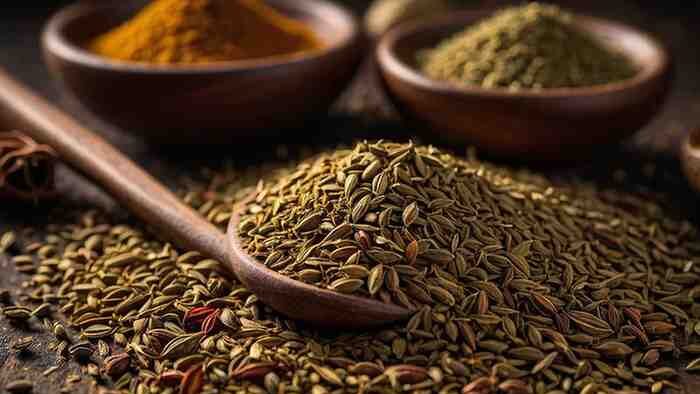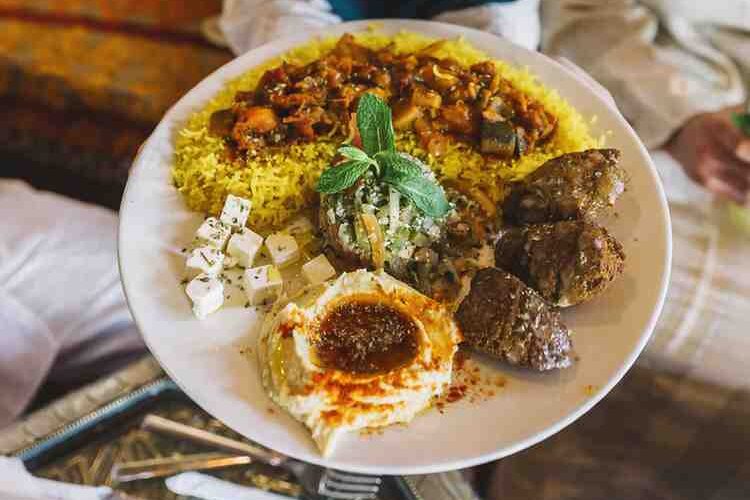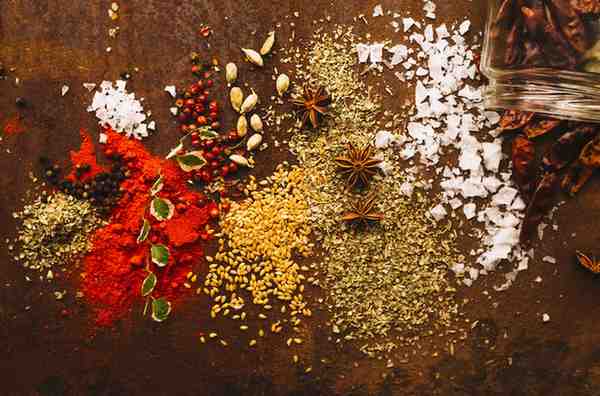Baharat, a traditional Middle Eastern spice blend, brings rich, aromatic warmth to many dishes. The word “Baharat” itself means “spices” in Arabic, which reflects its use as a versatile blend of flavorful, earthy, and slightly sweet spices. Used for centuries across the Middle East and North Africa, Baharat adds depth to everything from meats and stews to grains and vegetables. Its flavor profile is unique, combining warmth from cinnamon and cloves, earthiness from cumin, and a subtle sweetness from paprika.
- Versatile Use: Baharat can be used as a seasoning for meats, a flavor enhancer in soups and stews, and even as a rub for grilled dishes. It’s the perfect spice blend to have on hand for both traditional Middle Eastern recipes and creative culinary experiments.
- Aromatic and Flavorful: The blend’s aroma and taste reflect the complex, rich flavors of Middle Eastern cuisine, balancing both sweet and savory notes.
In Middle Eastern households, Baharat is a kitchen staple that captures the essence of regional cuisine in one aromatic blend. For cooks who want to explore new flavors or experiment with traditional dishes, Baharat is a spice worth trying.
The Origins and Cultural Background of Baharat
Baharat has a long and storied history in Middle Eastern cooking. Its roots go back centuries to the ancient spice trade routes, which connected the Middle East, Asia, and Europe. These routes brought a variety of spices from distant lands, and Middle Eastern cooks blended these spices to suit their local tastes and ingredients.
The Historical Significance of Baharat in Middle Eastern Cuisine
For centuries, Baharat has been a key component in Middle Eastern kitchens, especially in regions like Lebanon, Turkey, and North Africa. Here’s how it became such an essential part of regional cooking:
- Spice Trade Influence: The ancient spice routes allowed merchants to bring spices like cinnamon, cumin, and cloves from Asia and North Africa. These spices became widely used in Middle Eastern dishes and formed the basis of Baharat’s ingredients.
- Culinary Heritage: Each region created its own Baharat recipe, blending spices based on available ingredients and local preferences. Lebanese, Turkish, and Iraqi Baharat each have slight differences, reflecting the diverse cultures of the Middle East.
- Regional Adaptations: Baharat recipes passed down through generations have subtle variations depending on family traditions and regional influences. These adaptations make Baharat a blend that is as unique as it is flavorful.
The story of Baharat reflects the Middle East’s rich culinary heritage, with each ingredient representing a part of that history.
Key Ingredients in Baharat and Their Flavor Profiles
Baharat’s blend typically includes a handful of core spices, though the exact recipe can vary by region and preference. Each spice brings a unique flavor to the blend, contributing to Baharat’s warm, aromatic character.

Essential Ingredients in Baharat
While the recipe may differ, Baharat’s essential spices are generally consistent. Here’s a breakdown of these key spices and what they add to the blend:
- Cumin:
- Known for its earthy, slightly smoky taste, cumin serves as one of Baharat’s primary flavors.
- Adds a touch of bitterness that balances the sweeter spices in the blend.
- Coriander:
- Adds a mild, citrus-like flavor that lightens the blend.
- Coriander complements cumin by enhancing Baharat’s warm, earthy tones.
- Cinnamon:
- This warm, slightly sweet spice is a hallmark of Middle Eastern cooking.
- Adds depth to Baharat and pairs well with savory and sweet dishes alike.
- Cloves:
- Known for their intense aroma, cloves bring a slightly sweet, peppery heat.
- They add complexity, making Baharat suitable for both meat and vegetable dishes.
- Black Pepper:
- Adds a sharp, pungent note to the blend, balancing out the warmth of other spices.
- Its slight heat complements the richness of Baharat.
- Paprika:
- Adds color and a mild sweetness, rounding out the blend’s flavors.
- Paprika’s sweetness helps to balance the spice’s earthy and bitter notes.
These essential spices create the backbone of Baharat, producing a blend that’s both earthy and slightly sweet, with a hint of peppery heat.
Additional Ingredients and Variations
In addition to the core spices, some Baharat recipes include extra ingredients to enhance the flavor or aroma. These additions vary by region but often include:
- Cardamom:
- Adds a sweet, floral note, especially popular in Turkish and Lebanese blends.
- Complements cinnamon, creating a warm, aromatic balance.
- Nutmeg:
- Adds a subtle nutty warmth that enhances the blend’s richness.
- Pairs well with cloves and cinnamon, adding depth.
- Rose Petals or Saffron:
- Rose petals add a delicate floral note, especially in Turkish Baharat.
- Saffron, though less common, gives the blend a distinct, luxurious aroma and vibrant color.

Regional Variations in Baharat Spice Blends
Baharat varies not only from region to region but also from family to family. These differences add to the richness and diversity of Middle Eastern cooking. Here’s a look at a few popular regional variations:
- Lebanese Baharat:
- Lebanese blends often focus on warmth and sweetness, with extra cinnamon and cloves.
- It is typically milder, ideal for adding flavor without overwhelming heat.
- Turkish Baharat:
- Turkish Baharat may include mint or dried rose petals for a more floral, aromatic flavor.
- It’s often used in meat dishes, where the floral notes enhance the richness of lamb and beef.
- Iraqi Baharat:
- In Iraq, Baharat blends are often heavier on black pepper, creating a spicier, more intense blend.
- This version is especially popular in hearty stews and meat dishes.
Each region’s version of Baharat reflects local flavors and cooking traditions, making it a spice blend that’s as versatile as it is adaptable.
Tips for Making Baharat Spice Blend at Home
Creating your own Baharat at home allows you to customize the flavors based on your preferences. Here are a few tips to help you make a delicious, balanced Baharat blend:
- Use Fresh, High-Quality Spices: Fresh spices have the best aroma and flavor, which is crucial for Baharat’s complex taste. Choose spices with vibrant colors and strong scents.
- Toast the Spices for Extra Depth: Toasting whole spices like cumin, coriander, and cloves before grinding can add depth to the blend. Toasting releases natural oils, enhancing the spices’ flavors.
- Grind in Small Batches: If possible, grind only what you need for a few weeks. Freshly ground spices retain more flavor and aroma than pre-ground options.
- Experiment with Ratios: Adjust the amounts of cinnamon, pepper, or cloves to match your taste. If you prefer a milder blend, use less black pepper; for a sweeter blend, add more cinnamon or paprika.
- Store in an Airtight Container: Baharat should be stored in a cool, dark place in an airtight container. This preserves the blend’s aroma and flavor for up to six months.
Making Baharat at home lets you explore different flavor profiles, creating a blend that suits your favorite recipes and personal taste preferences.
Traditional and Modern Culinary Uses of Baharat
Baharat’s warm, aromatic blend of spices makes it ideal for both traditional Middle Eastern dishes and modern recipes. It adds depth to a range of foods, from meats to vegetables to grains. Let’s explore how to use Baharat in your cooking.
Traditional Dishes Using Baharat
In Middle Eastern cuisine, Baharat is a go-to seasoning for many classic recipes. Here are some popular ways it’s traditionally used:
- Grilled Meats: Baharat works beautifully as a dry rub for lamb, beef, and chicken. The blend’s warmth enhances the richness of meats, making it a common choice for kebabs or grilled lamb.
- Stews and Soups: Baharat adds depth to slow-cooked stews and soups, especially those with beef or lamb. Its blend of spices complements the hearty flavors of Middle Eastern-style lamb stew or lentil soup.
- Rice and Grain Dishes: The blend’s subtle warmth pairs well with grains, making it perfect for spicing up rice pilaf, couscous, or even bulgur wheat. Baharat adds a comforting aroma and a slight hint of sweetness to these side dishes.
- Vegetable Dishes: Roasting or grilling vegetables with Baharat transforms simple ingredients into flavorful sides. Root vegetables like carrots, sweet potatoes, and zucchini pair particularly well with this spice blend.

Modern and Creative Uses for Baharat
In addition to traditional recipes, Baharat is a versatile spice that can add a unique twist to modern dishes. Here are a few creative ways to use it:
- Marinades and Sauces: Mixing Baharat into marinades or sauces adds layers of flavor, especially when paired with olive oil, lemon juice, and garlic. It’s excellent for marinating meats, adding richness and complexity.
- Roasted Nuts and Snacks: Try coating almonds, cashews, or popcorn with a bit of Baharat and olive oil for a quick, flavorful snack.
- Baked Goods: Baharat can also enhance sweet recipes. Adding a pinch to cakes, cookies, or pastries gives a warm, spiced undertone that pairs well with flavors like chocolate and vanilla.
- Salad Dressings: Add a dash of Baharat to your salad dressings for a surprising layer of spice and warmth, especially in vinaigrettes that include honey or balsamic vinegar.
These modern applications allow you to experiment with Baharat in new ways, making it a versatile addition to any kitchen.
Health Benefits of Baharat Spice Blend
Baharat isn’t just flavorful—it’s also packed with health benefits. Each ingredient contributes nutrients and beneficial compounds that support overall well-being. Here’s a look at how Baharat can positively impact health.
Key Health Benefits of Baharat’s Ingredients
Each spice in Baharat brings unique health properties, making this blend as nourishing as it is flavorful.
- Antioxidant Properties:
- Spices like cinnamon, cloves, and paprika are high in antioxidants, which help protect cells from oxidative damage.
- Antioxidants support cellular health, which can contribute to anti-aging and disease prevention.
- Anti-inflammatory Benefits:
- Cumin and coriander, two primary ingredients in Baharat, are known for their anti-inflammatory properties. Regular consumption may help reduce inflammation, which is linked to conditions like arthritis.
- Cinnamon also contains compounds that reduce inflammation, making Baharat a good choice for anyone interested in anti-inflammatory foods.
- Immune Support:
- Cardamom and coriander both have antimicrobial properties, which help combat harmful bacteria and support immunity.
- Black pepper, another Baharat ingredient, can aid in the absorption of nutrients, which supports immune function.
These health benefits make Baharat not only a tasty spice blend but also a functional one, adding both flavor and nutrients to meals.
Incorporating Baharat into a Healthy Diet
To enjoy the health benefits of Baharat, try incorporating it into a balanced diet rich in whole foods. Pairing Baharat-seasoned dishes with vegetables, whole grains, and lean proteins will maximize its nutritional impact. For a wellness-focused diet, use Baharat in recipes that focus on whole ingredients, allowing its health benefits to shine.
FAQs About Baharat Spice Blend
Baharat is a unique spice blend that often raises questions for those new to Middle Eastern cooking. Here are some frequently asked questions to help you better understand Baharat and its uses.
What spices are typically in Baharat?
- Traditional Baharat includes cumin, coriander, cinnamon, cloves, black pepper, and paprika. Some regional variations may also add cardamom, nutmeg, or rose petals.
Is Baharat spicy?
- Baharat has a warm, earthy flavor with a hint of sweetness and mild spice. It’s not as hot as some other blends, making it suitable for those who prefer subtle heat.
How do you use Baharat in cooking?
- Baharat can be used as a rub for meats, a seasoning in soups and stews, or even a flavor enhancer in grains and roasted vegetables. It’s versatile and can be adapted to many recipes.
Can you make Baharat at home?
- Yes, Baharat can be easily made at home by blending the core spices and adjusting quantities to taste. Homemade Baharat allows you to control the flavor profile and freshness of the spices.
What’s the difference between Baharat and Ras el Hanout?
- While both are Middle Eastern spice blends, Baharat is generally milder and less complex than Ras el Hanout, which includes a larger variety of spices. Ras el Hanout often has a more floral and spicy profile, whereas Baharat is earthier and more balanced.
These FAQs provide helpful insights for anyone interested in exploring Baharat in their cooking, offering guidance on its composition, flavor, and versatility

